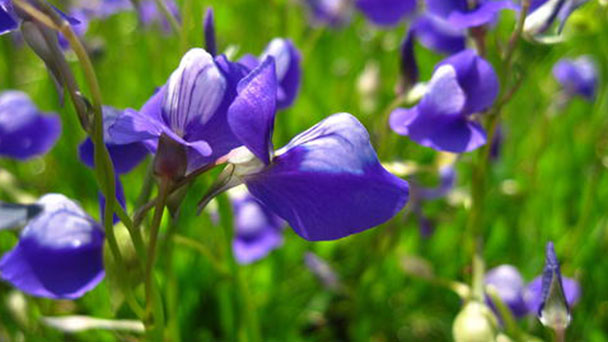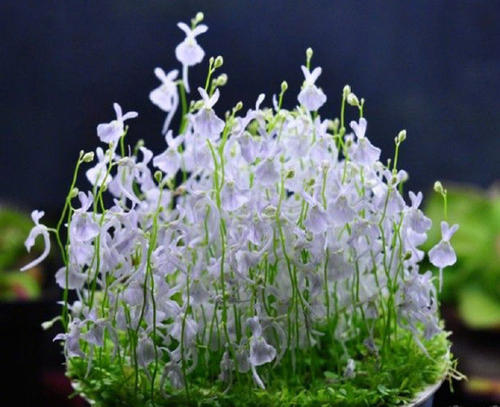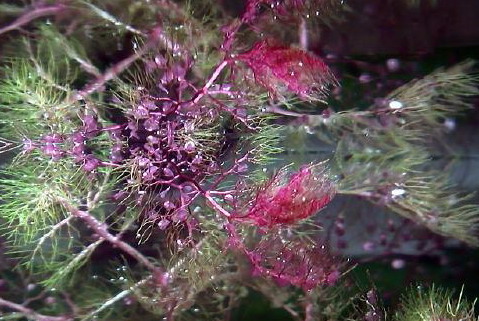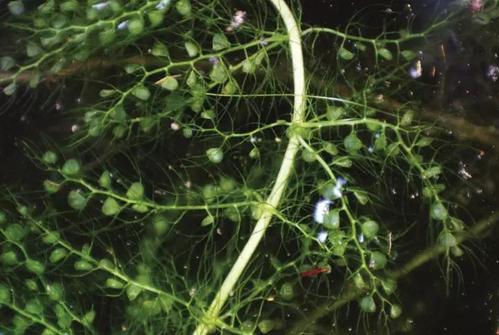Utricularia Vulgaris (Greater Bladderwort) Profile
Written by Maggie
Oct 30 2021

Utricularia Vulgaris (Greater Bladderwort), also called common bladderwort, is a dicotyledonous planktonic or submerged aquatic plant that has no roots and can float in water. Utricularia Vulgaris is the most representative aquatic plant of the genus Utricularia Vulgaris.
Green or yellow-green plant body, utricularia vulgaris has as long as 100 CMS above the delicate main stem axis, and then by the stem axis on both sides of the growth of branches and in the branch of the growth of beautiful pinnate needle shaped leaf. Their traps are usually green to yellow-green in color and can feed on and digest microorganisms in water.
Cultivation in aquarium tanks, filling bursa may disappear. Flower stems are axillary, with long pedunculated, racemes, usually 4 flowers, open with a beautiful yellow lipped corolla. Utricularia Vulgaris is a small insectivorous plant with a moveable sac-like trap structure that can absorb and digest small organisms. Utricularia Vulgaris comes in many varieties and forms, often growing in clumps on the mossy trunks of wetlands, ponds and even tropical rainforests. Many have a long flowering period and produce clusters of lovely little flowers.
It is a Utricularia Vulgaris variety due to its dense, slender pinnate leaves and graceful grasses, but must be grown with the stems fixed. Utricularia Vulgaris can adapt to the environment of aquarium tanks, and grow fast, in a short period of time may be full aquarium tanks, so must be regularly trimmed.
Utricularia Vulgaris Picture

Characteristics of Utricularia Vulgaris
Utricularia Vulgaris Leaf
Utricularia Vulgaris is a perennial aquatic caterpillar. Stem is thicker, cordaceous, and much branched. Leaves are alternate, showing two pinnate divisions, lobes linear, 2-4cm long, margin with spiny teeth, pinnules under the trap sac, ovate, short pedicel.
Utricularia Vulgaris Flowers
Scapes of Utricularia Vulgaris are 15 -- 25cm long, sparsely flowers 7 -- 11, pedicels 1 -- 1.5cm long; Bracts and scales are ovate, apically obtuse, hyaline, membranous, 3 -- 5mm long; Calyx is 2-lobed, upper lobes broadly lanceolate, acute, lower lobes broadly ovate, apex 2-lobed; Corolla is yellow, labiate, upper lip broadly ovate, lower lip longer, apex 3 lobed; Utricularia Vulgaris has 2 stamens; Ovaries are 1-loculed, stigma rounded, membranous. Capsule is globose, ca. 5mm in diameter, surrounded by persistent calyx outside; Seeds are numerous, hexagonal.
Utricularia Vulgaris is an aquatic or terrestrial annual herb. Vane, pinnate compound leaves, divided into numerous, filamentous lobes, lobes with vesicles at base, or alternate in terrestrial species, often vanishing before anthesis. Racemes arranged on flower stems; Flowers are bisexual, zygomorphic, few, yellow, lavender, or white; Calyx 2 crack; Corolla is 2-lipped, base spur; Utricularia Vulgaris has 2 stamens; Ovary is superior, 1-loculed, with many ovules. Small capsule. The stems of Utricularia Vulgaris are usually horizontal, epiphytic or floating. Leaves are simple or divided. Flowers are bisexual, bilaterally symmetric (diciliate), 5 conjunctive petals, 2 sepals;
The morphology of Utricularia Vulgaris is very interesting, and the common distinctions between roots, stems, and leaves do not apply.In aquatic species, the leaves are filamentous and rootless. Flowers are on short branches, protruding from the water, in addition, also on the main axis of the short branches to the water, and have very small leaves.T here are many small cysts on the submerged leaves and a membrane flap at the mouth. The structure of the trap makes it possible for small aquatic animals to enter and not exit. If they swim into the trap, they will be digested by an enzyme secreted by the tissue inside the trap. Terrestrial species have special fibrous branches extending in the moss or soil layer.
Utricularia Vulgaris is a perennial herb (a few are annual) and can be found in ponds, ditches, wetlands, trunks of rainforests, etc. Utricularia Vulgaris has long stolons, rootless, impeller or single leaf on stolon branches, aquatic populations have filamentous, often forked leaves, and catapultes at the base of stolon branches or leaves. Flower stems are slender, raceme or a flower top, corolla two - lipped, the base of the distance. Capsule is globose, dehiscent at maturity to disperse fine seeds.
Habits of Utricularia Vulgaris
Utricularia Vulgaris, which has spent its entire life in water, has few roots, a thin stem and leaves all over its body that break into filaments like a tangle of green hair.In the summer, a stalk is raised from its stem to the surface of the water, and a few small purple and yellowish-butterfly flowers grow on the top of the stalk. The Utricularia Vulgaris is an aquatic insect-eating plant with small pouches around its leaves that are used for catching insects.
Each pocket has an opening to the outside, and a small lid with four hairs growing on the lid. When the water insect swims to the door of the small bag, as long as gently touch, the small cover opens to the inside, the insect swims into the pocket and can not come out again, because the cover can only be opened from the outside to the inside, but can not be pushed out from the inside. But Utricularia Vulgaris can't produce digestive juices the way other insectivorous plants do, so it must be absorbed slowly after the insects that snare themselves have starved and rotted. Utricularia Vulgaris is often found in rice paddies, swamps and ponds and is found almost everywhere in China.
How to Grow and Care for Utricularia Vulgaris
Utricularia Vulgaris mostly prefers bright light, very wet substrates or water.
Utricularia Vulgaris Soil Care
Terrestrial and epiphytic populations can be planted with water moss or peat alone, or 1/2 perlite or river sand can be added to them; Aquatic population can use a container filled with water to spread a thin layer of acid substrate at the bottom, can use peat (wet before use), river sand, acid granular soil, etc., in order to facilitate the stability of water quality, such as conditions can use professional aquarium and reference to the cultivation of aquatic plants.
Utricularia Vulgaris Watering
Use water with low mineral concentration. In the growing season of land population, it is suitable to adopt the high-water basin-soaking method to maintain the high humidity of the substrate. The basin-soaking method can be canceled in dormancy or in winter, and the substrate can be kept slightly wet. The epiphytic population needs to maintain high humidity and good air permeability of the substrate, and can also be planted by basin immersion method with low water level. Aquatic population should be replaced 1 ~ 2 times per month according to the water quality, each time about 1/3 of the total water quantity.
Utricularia Vulgaris Humidity Care
The air humidity of Utricularia Vulgaris should be maintained at more than 50%, which can be satisfied in the general planting environment.

Utricularia Vulgaris Temperature Care
Utricularia Vulgaris is distributed over a wide area and has different temperature requirements. Most of the Utricularia Vulgaris can survive at 10 ~ 32 degrees Celsius, and some varieties can withstand low temperatures of 0 degrees Celsius or high temperatures of 37 degrees Celsius.
Utricularia Vulgaris Lighting Requirements
Utricularia Vulgaris prefers bright light and can tolerate semi-shade. Aquatic and terrestrial species can also accept soft sunlight, but should avoid strong sunlight exposure.
Utricularia Vulgaris Fertilizer
In the growing season, terrestrial and epiphytic populations can use common compound fertilizer dilution 5000 times spray foliage, 1 ~ 2 times a month. The aquatic population can be halved when the water is changed every month, adding aquatic grass liquid fertilizer, which can refer to the cultivation method of aquatic grass. Small amounts of water fleas may also be fed as live food for aquatic Utricularia Vulgaris.
Utricularia Vulgaris Pruning
Utricularia Vulgaris is an insectivorous plant that is easy to reproduce, and the Utricularia Vulgaris is a new plant when the long stem is cut.
Utricularia Vulgaris Winter buds
Some temperate species grow winter buds under the stimulation of low temperature in winter, and new plants will grow when the temperature warms up in spring.
Utricularia Vulgaris Seeding
Land population seeding can be directly scattered on the clean substrate surface, maintain high humidity and bright light, aquatic population can be directly sown seeds in the water surface, the temperature is suitable for about 1 ~ 2 months germination.
Varieties of Utricularia Vulgaris
Algae have a wide range of habitats and can be divided into aquatic, epiphytic, terrestrial and shallow aquatic organisms according to their growth habits. There are also a few Utricularia Vulgaris species that grow in special environments, such as flowing rock walls, crevices, and tree trunks. They live mostly in other plants or under the water, and are insectivorous plants that do not like bright light.
There are about 170 species of Utricularia Vulgaris: mostly grow in streams, ponds, marshes and other water sources near the moist land.The stalks and traps are born below the ground, with leaves protruding from the stalks.
About 40 species of aquatic: in streams, ponds, lakes and other water surfaces, floating in the water growth, can move with the current.
About 30 species in shallow water: on the edge of water sources such as ponds and marshes, the water depth is usually only a few centimeters, the stems grow under the soil at the bottom, and the leaves float on the surface.It can tolerate high water levels during the rainy season and the whole plant is submerged. During the dry season, the water recedes, but the soil remains moist enough for the species to survive.
About 20 species of epiphytes: attached to rocks, tree trunks, moss or humus, also can be attached to some water in the leaf axils of pineapple.
Some species have multiple growth habits, which can be found either on mossy trunks or on land in marsh grasslands.
Utricularia Vulgaris Distribution
Utricularia Vulgaris is distributed around the world. China is mainly distributed in the provinces of the Yangtze River and Yellow River basin. In addition, Utricularia Vulgaris can also be collected from ponds in Jilin and Inner Mongolia.
Utricularia Vulgaris is produced in Heilongjiang, Jilin, Liaoning, Inner Mongolia, Hebei, Shanxi, Shaanxi, Gansu, Qinghai, Xinjiang, Shandong, Henan and Sichuan provinces.

Latest Updated
- Benefits of Bugleweed - 7 Science-backed Health Benefits
- Bugleweed Dangers & Side Effects - Is It Poisonous?
- How to Plant Evergreen Trees - What You Should Know
- When to Plant Evergreens - Grow Guide for Evergreen Trees
- 12 Wonderful Evergreen Shrubs for Your Garden
- 12 Popular Evergreen Plants with Pictures for Beginners
- When And How To Prune A Lilac Bush Like a Pro
- How to Grow & Care for Lilac Vine (Hardenbergia Violacea)
- Japanese Lilac Tree (Syringa Reticulata) Care & Propagation Guide
- Shumard Oak Pros and Cons - What to Know
Popular Articles
- Winter maintenance of Antirrhinum Majus
- How to Grow Terminalia Mantaly Tree
- How to Grow and Care for Crossostephium Chinense
- How to grow Antirrhinum Majus in spring
- Peristeria Elata (Dove Orchid) Profile: Info & Care Guide
- Underwatered Snake Plant (Sansevieria Trifasciata) - Signs And How To Fix
- How to Care for Brazilian Jasmine Plant (Mandevilla Sanderi)
- How to Grow & Care for Graptopetalum Purple Delight in Summer
- Rosa Chinensis (China Rose): Plant Growing & Care Tips
- How to Care for Baby Sun Rose (Aptenia Cordifolia)